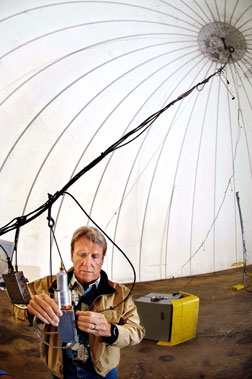NEWS RELEASES
FOR IMMEDIATE RELEASE
Feb. 16, 2007
Fred Harper to speak at AAAS annual meeting
Senior Sandia scientist to discuss first response guidance for “dirty bomb” scenarios

Fred Harper. (Photo by Randy Montoya)
Download 300dpi JPEG image, “fred-harper.jpg,” 788K (Media are welcome to download/publish this image with related news stories.)
ALBUQUERQUE, N.M. — If a so-called “dirty bomb ” exploded in a populated area, first responders would make immediate decisions to lessen health impacts on people potentially exposed to radioactive material.
Fred Harper, Sandia National Laboratories senior scientist, and Steve Musolino, Brookhaven Lab researcher, will be among five speakers discussing possible responses to such scenarios at the upcoming AAAS Annual Meeting in San Francisco, Calif.
Harper and Musolino will offer guidance to first responders, planners, and other decision makers for protective actions during the first 48 hours after such a device — formally known as a radiological dispersal device (RDD) — has been detonated.
Both talks will be part of the 90-Minute “Coping with a Dirty-Bomb Detonation ” Symposium in the “Understanding and Managing Societal Risks ” track. Harper will present his talk, “Radiological Dispersal Devices: Physically Based Dispersal Characteristics and Limitations, ” along with Brookhaven Lab’s Stephen Musolino’s talk, “First Response after a Dirty Bomb Attack. ” The track runs Saturday, Feb. 17, from 2 to 3:30 p.m. at the Renaissance Parc 55 Hotel.
“By the time it is known that an attack has occurred, most likely there will have been casualties, all the radioactive material will have been released and it will have begun to disperse, ” Musolino says. “The goal of this research is to provide science-based response recommendations to the U.S. Department of Homeland Security to consider for use in community preparedness activities. ”
Sandia is a National Nuclear Security Administration (NNSA) laboratory.
Over the past two decades, Harper and his team have conducted more than 600 explosive experiments at Sandia to determine how the radioactive material in a RDD would disperse in the environment through aerosolization, which forms a cloud of particles. In these experiments, the quantities of material used to simulate the radioactive material, the shock physics, and the aerosol physics are representative of what might occur in the detonation of an actual device. This information was then applied to predict the dispersal of actual radioactive sources using many different device designs.
More recently, Harper has been studying the interaction high explosive fireballs with different urban surfaces like asphalt, concrete, grass, and dirt on the dispersal of radioactive aerosol. These recent studies were performed jointly with Defence Research and Development Canada. The research was performed so that the dispersal characteristics of most realistic radioactive sources could be predicted accurately, says Harper.
The guidance derived from this work instructs first responders on interpreting radiation levels and assists them with decisions such as where to locate a command post, how to triage contaminated personnel who may need medical evaluations due to inhalation of radioactive material and, equally important, how to handle those who do not need an urgent medical exam for radiation injury.
Their guidance recognizes that management of public health for the effects of an RDD is very different than the approach taken for chemical or biological terrorism, and gives first responders and planners science-based options for new response strategies. While the particulate cloud from a RDD can be hazardous, it is not as immediately dangerous to life and health as anthrax or chemical agents.
“These new strategies will speed up lifesaving efforts to aid the injured victims and minimize the overall radiation dose to the public,” Musolino says. “I hope a terrorist act with a RDD never happens. But if it does, we want the first responders to have the best science behind the tough decisions they will make in those first critical hours.”
The research was funded primarily by the Department of Energy and the Defense Department’s Defense Threat Reduction Agency. Recently, the Department of Homeland Security (DHS) and Nuclear Regulatory Commission contributed to the work, with DHS coordinating the outreach effort with the first responder community.
Sandia is a multiprogram laboratory operated by Sandia Corporation, a Lockheed Martin company, for the U.S. Department of Energy’s National Nuclear Security Administration. Sandia has major R&D responsibilities in national security, energy and environmental technologies, and economic competitiveness.
Sandia news media contact: Stephanie Holinka, slholin@sandia.gov, (505) 284-9227